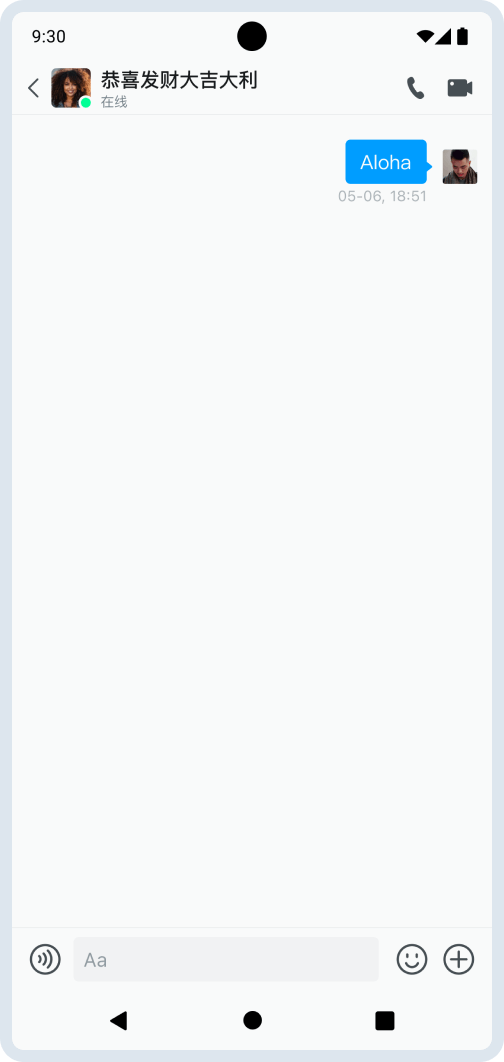快速开始
快速开始
利用环信单群聊 UIKit,你可以轻松实现单群和群聊。本文介绍如何快速实现在单聊和群聊会话中发送消息。
前提条件
开始前,请确保你的开发环境满足以下条件:
- DevEco Studio NEXT Release(5.0.3.900)及以上;
- HarmonyOS SDK API 12 及以上;
- HarmonyOS NEXT.0.0.71 或以上版本的模拟器或者真机;
- 有效的环信即时通讯 IM 开发者账号和 App Key,请参见 环信控制台文档。
项目准备
本节介绍将单群聊 UIKit 引入项目中的必要环境配置。
打开 DevEco Studio,点击 Create Project。
在 Choose Your Ability Template 界面,选择 Application > Empty Ability,然后点击 Next。
在 Configure Your Project 界面,依次填入以下内容:
- Project name:你的 HarmonyOS 项目名称,如 HelloWorld。
- Bundle name:你的项目包的名称,如 com.hyphenate.helloworld。
- Save location:项目的存储路径。
- Compatible SDK:项目的支持的最低 API 等级,选择
5.0.0(12)及以上。 - Module name:module的名称,默认为
entry。
点击 Finish。根据屏幕提示,安装所需插件。
上述步骤使用 DevEco Studio 5.1.0 Release(5.1.0.828) 示例。
- 在项目中引入 SDK。
远程依赖
在项目根目录下执行如下命令:
ohpm install @easemob/chatuikit
提示
上面的命令在根目录执行,会将 SDK 依赖添加到项目级别;如果要将 SDK 依赖到 Module 级别,需要在对应的 Module 目录下执行上面的命令。
若要查看 UIKit 的最新版本号,请参见 更新日志。
源码依赖
从 GitHub 或 Gitee 上获取 UIKit 源码,按照下面的方式集成:
- 点击 Import,选择 Import Module,导入
chatuikit模块。 - 在项目 Module 中引入
chatuikit模块。
修改模块目录的 oh-package.json5 文件,在 dependencies 节点增加依赖声明。
"dependencies": {
"@easemob/chatuikit": "file:./../chatuikit"
}
然后点击同步按钮,同步完成后,就可以在模块中使用 chatuikit 。
- 添加项目权限。
在模块的 module.json5 ,例如:HelloWorld 中 entry 模块的 module.json5 中,配置示例如下:
{
module: {
requestPermissions: [
{
name: "ohos.permission.GET_NETWORK_INFO",
},
{
name: "ohos.permission.INTERNET",
},
{
"name": "ohos.permission.MICROPHONE",
"reason": "$string:record_permission_reason",
'usedScene': {
"abilities": [
"EntryAbility"
],
"when": "always"
}
}
],
},
}
需要在对应模块的 string.json 文件中增加如下:
{
"name": "record_permission_reason",
"value": "录制语音需要"
}
实现发送第一条单聊消息
本节介绍如何通过单群聊 UIKit 实现发送第一条单聊消息。
创建快速开始页面及实现代码逻辑
- 打开
entry/src/main/ets/pages/Index.ets文件,并替换为如下内容:
import { ChatPageParams, ChatUIKitClient, ChatClient, ChatError, ChatOptions, ConversationType } from '@easemob/chatuikit';
@Entry
@Component
struct Index {
pathStack: NavPathStack = new NavPathStack();
private appKey: string = [项目的AppKey]; // 将[项目的AppKey]替换为项目的 App Key 字符串
private userId: string = '';
private token: string = '';
private peerId: string = '';
private initSDK() {
let options = new ChatOptions({
appKey: this.appKey
});
options.setAutoLogin(false);
let client = ChatClient.getInstance();
client.init(this.getUIContext().getHostContext(), options);
ChatUIKitClient.init(client);
}
private login() {
if (!this.userId || !this.token) {
this.getUIContext().getPromptAction().showToast({message: "UserId or token cannot be empty!"});
return;
}
ChatUIKitClient.login(this.userId, this.token)
.then(() => {
this.getUIContext().getPromptAction().showToast({message: "Login successful!"});
})
.catch((e: ChatError) => {
this.getUIContext().getPromptAction().showToast({message: "Login failed: "+e.description});
})
}
private logout() {
ChatUIKitClient.logout(false)
.then(() => {
this.getUIContext().getPromptAction().showToast({message: "Logout successful!"});
})
}
private startChat() {
if (!this.peerId) {
this.getUIContext().getPromptAction().showToast({message: "Peer id cannot be empty!"});
return;
}
this.pathStack.pushPath({name: 'ChatPage', param: {
conversationId: this.peerId,
conversationType: ConversationType.Chat
} as ChatPageParams})
}
aboutToAppear(): void {
this.initSDK();
}
build() {
Navigation(this.pathStack) {
Column() {
TextInput({placeholder: 'UserId'})
.commonStyle()
.onChange(value => this.userId = value)
TextInput({ placeholder: 'Token', text: this.token })
.commonStyle()
.onChange(value => this.token = value)
Button('Login')
.commonStyle()
.onClick(()=> {
this.login();
})
Button('Logout')
.commonStyle()
.onClick(()=> {
this.logout();
})
TextInput({placeholder: 'PeerId'})
.commonStyle()
.onChange(value => this.peerId = value)
Button('Start Chat')
.commonStyle()
.onClick(()=> {
this.startChat();
})
}
.width('100%')
.height('100%')
}
}
@Styles
commonStyle() {
.width('80%')
.margin({
top: 20
})
}
}
- 现在可以测试你的应用。
发送第一条消息
在聊天页面下方输入消息,然后点击发送按钮发送消息。

测试应用
在 DevEco Studio 中,点击
Run ‘entry’按钮,将应用运行到你的设备或者模拟器上。输入用户 ID 和密码,点击
Login按钮进行登录,登录成功或者失败有提示,或者通过 Log 查看。在另一台设备或者模拟器上登录另一个账号。
两台设备或者模拟器分别输入对方的账号,并点击
Start Chat按钮,进入聊天页面。现在你可以在两个账号间进行聊天。
